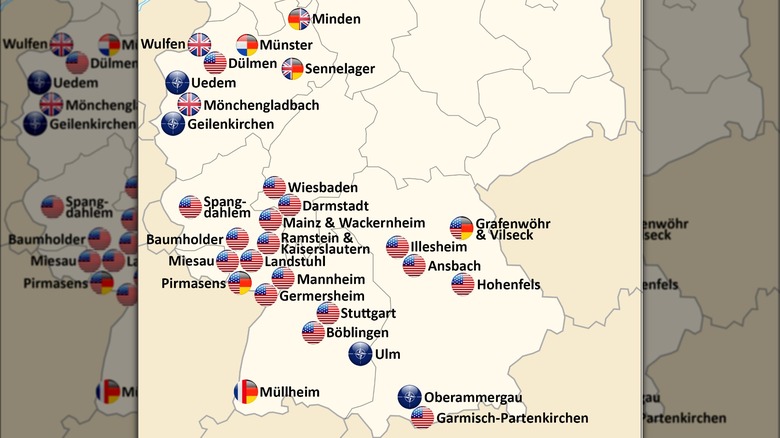How Did The US Get So Many Military Bases Around The World?
If you've ever served in the United States military, you likely know of the many assignments outside of the U.S. These are known as OCONUS or Outside Continental United States, and while the term covers Alaska, Hawaii, and U.S. territories, it also includes a whole bunch of other nations. Every major branch has bases around the world, so the U.S. military has a presence in every continent (except Antarctica, which bans drones and military operations, forbidden by the Antarctic Treaty of 1961).
There are multiple reasons why the U.S. deems it necessary to place its personnel all over the world. After World War II, the U.S. realized it needed to extend its reach further, contrary to previous isolationist policies that resulted from the nation's losses in World War I. So the U.S. installed permanent military bases in Germany, Spain, Italy, and elsewhere. There are about 750 U.S. military bases of various sizes spread across 80 or so countries.
Placing its personnel across the planet offers several benefits for the military, including improving force protection, enabling a quick reaction force to deploy anywhere in the world with little notice or time required, and force projection, which tells potential enemies and known threats that the full might of the U.S. military isn't on the other side of the planet — it's much closer, and capable of reaching just about anywhere.
World War II changed how the U.S. saw the rest of the world
After World War I, the U.S. withdrew its military forces and downsized them considerably. With the Great Depression striking at the tail end of the 1920s, getting involved in European, African, or Asian matters wasn't at the forefront of American policy. This continued into World War II; the U.S. became directly involved only after a Japanese sneak attack caused huge ship losses at Pearl Harbor, Hawaii, destroying most of America's Pacific naval might.
Because of the widespread destruction across Europe and Japan during the war, it became necessary to support rebuilding there. The U.S. and its allies divided Germany, with the Soviet Union controlling the East, while the others maintained order in the West. This division, alongside ideological differences between capitalist and communist governments, led to the Cold War, and the U.S. continued to spread its might across the world.
America has maintained a constant presence in Germany since the end of the war, as well as a presence in Japan. The treaty that ended World War II limited what Japan could do in terms of its military, so the U.S. military continued to function as its protector, though Japan has the Japan Self-Defense Force for the nation to protect itself and its in the region. These reasons and others pushed the U.S. to distribute its forces widely, and this practice even included the Pentagon's former secret base under the Greenland ice.
How American military bases are distributed around the world
The reasons for maintaining American bases in other countries have changed since the Cold War ended. After 9/11, the reasons the U.S. maintained its worldwide footprint included fighting two wars in the Middle East, establishing constabulary forces in various locations, detaining adversaries on foreign soil, and stabilizing regions with a large U.S. presence. The U.S. couldn't have engaged in the wars in Afghanistan and Iraq as efficiently without its presence in Kuwait, Qatar, Kyrgyzstan, and other nearby nations.
Today, the U.S. still maintains many of the bases established during the Cold War, though some have closed. Most are in Europe and East Asia, though some are in Africa and Latin America, and there's a U.S. presence in Australia. While Germany has a bunch of American bases, the country with the most overall is Japan. As of 2025, the U.S. operates 23 major military bases in Japan, but when you include all of the smaller bases, the number jumps to 120.
Those bases house more than 53,000 American military personnel, so America's presence there isn't small. It's also large in Germany, with 119 U.S. bases, and South Korea, where 73 U.S. bases help counter the threat from North Korea. President Donald Trump has indicated an interest in shrinking the U.S. presence overseas, so these numbers may change, but as of early 2025, the U.S. continues to send its men and women in uniform across oceans to serve in foreign lands.


